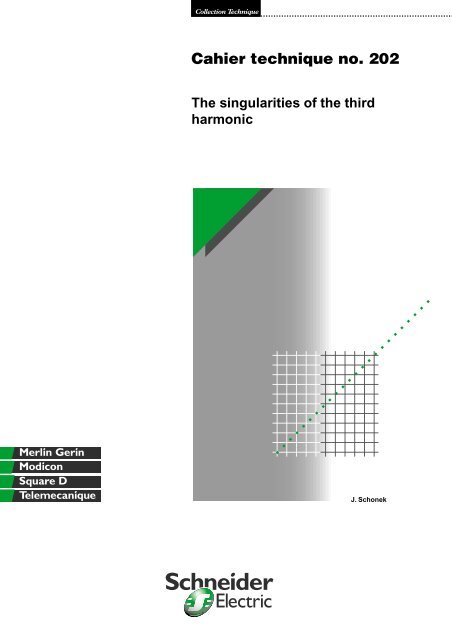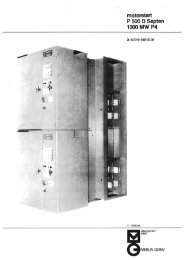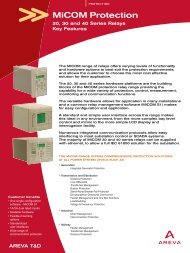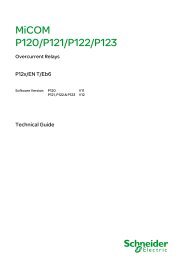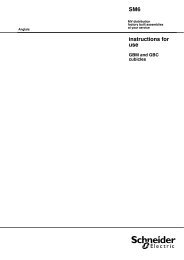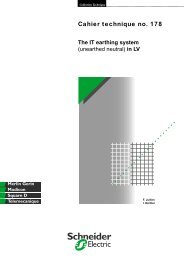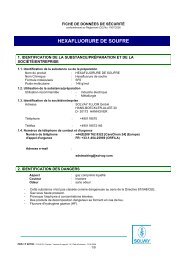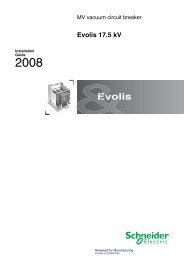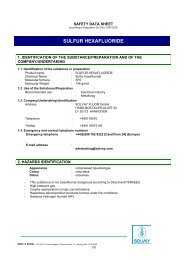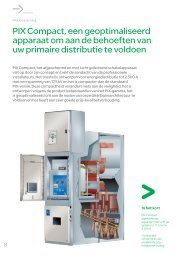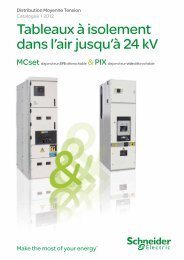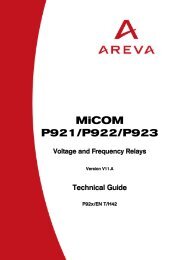You also want an ePaper? Increase the reach of your titles
YUMPU automatically turns print PDFs into web optimized ePapers that Google loves.
Collection Technique ..........................................................................Cahier technique no. 202The singularities of the thirdharmonicJ. Schonek
“Cahiers Techniques” is a collection of documents intended for engineers andtechnicians, people in the industry who are looking for more in-depthinformation in order to complement that given in product catalogues.Furthermore, “Cahiers Techniques” are often considered as helpful “tools” fortraining courses.They provide knowledge on new technical and technological developments inthe electrotechnical field and electronics. They also provide betterunderstanding of various phenomena observed in electrical installations,systems and equipment.Each “Cahier Technique” provides an in-depth study of a precise subject inthe fields of electrical networks, protection devices, monitoring and controland industrial automation systems.The latest publications can be downloaded from the <strong>Schneider</strong> <strong>Electric</strong>Internet web site.Code: http://www.schneider-electric.comSection: The expert’s placePlease contact your <strong>Schneider</strong> <strong>Electric</strong> representative if you want either a“Cahier Technique” or the list of available titles.The “Cahiers Techniques” collection is part of <strong>Schneider</strong> <strong>Electric</strong>’s“Collection Technique”.ForewordThe author disclaims all responsibility subsequent to incorrect use ofinformation or diagrams reproduced in this document, and cannot be heldresponsible for any errors or oversights, or for the consequences of usinginformation or diagrams contained in this document.Reproduction of all or part of a “Cahier Technique” is authorized with theprior consent of the Scientific and Technical Division. The statement“Extracted from <strong>Schneider</strong> <strong>Electric</strong> “Cahier Technique” no. ....” (please specify)is compulsory.
no. 202The singularities of thethird harmonicJacques SCHONEKAn ENSEEIHT engineer with a PhD in Engineering from the Universityof Toulouse, he was involved in designing variable speed drives forthe Telemecanique brand from 1980 to 1995.Subsequently he became the manager of the Harmonic Filteringgroup.He is currently responsible for Electrotechnical Applications andNetworks in the Advanced Design Office of <strong>Schneider</strong> <strong>Electric</strong>’s LowVoltage Power Division.ECT 202(e) first issued February 2001
Cahier Technique <strong>Schneider</strong> <strong>Electric</strong> no. 202 / p.2
The singularities of the third harmonicIn installations where the neutral is distributed, non-linear loads may causesignificant overloads in this conductor due to the presence of the thirdharmonic.Both the phenomenon and its remedies are explained in this“Cahier Technique”.Contents1 Origin of harmonics 1.1 Current drawn by non-linear loads p. 41.2 Symmetrical non-linear loads p. 41.3 3-phase loads p. 51.4 Single-phase loads p. 62 Overload on the neutral conductor 2.1 Third harmonics and multiples of 3 p. 72.2 Calculating the rms value of the neutral current p. 82.3 Overload on the neutral conductor as a function ofcurrent distortion p. 93 The third harmonic in transformers 3.1 Star-delta transformer p. 113.2 Transformer with zigzag secondary p. 114 Remedies 4.1 Adapting the installation p. 124.2 Star-delta transformer p. 124.3 Transformer with zigzag secondary p. 124.4 Reactance with zigzag connection p. 124.5 Third order filter in the neutral p. 134.6 Filtering devices p. 14Appendix: Calculating Fourier coefficients for a rectangular current p. 15Bibliography p. 16Cahier Technique <strong>Schneider</strong> <strong>Electric</strong> no. 202 / p.3
1 Origin of harmonics1.1 Current drawn by non-linear loadsHarmonic currents are generated by non-linearloads, ie. loads which draw a current with adifferent form from the voltage which powersthem. The most common loads of this type arethose based on rectifier circuits.A typical non-linear load, such as that shown infigure 1, draws a current containing all harmonicorders, both odd and even. The appearance ofthe current drawn, which has two differenthalf-waves, and its harmonic spectrum areshown in figures 2 and 3.(A)6420-2-4t(s)0 0.020.04Fig. 2: Appearance of the current drawn10090807060(%) 5040302010Fig. 1: Example of a typical non-linear load(non-symmetrical)01 3 5 7 9 11 13 15 17 19Harmonic orderFig. 3: Spectrum of the current drawn1.2 Symmetrical non-linear loadsHowever, the majority of loads connected to thenetwork are symmetrical, ie. the currenthalf-waves are equal and opposing. This can beexpressed mathematically by the equation:f( ωt + π) = − f( ωt)In this case, the even order harmonics arezero. Assuming that the current includes asecond order harmonic, it is possible to write, forexample:This gives:I( ωt + π) = I sin ( ωt + π) + I sin 2( ωt + π)1 2I( ωt + π) = − I sin ωt + I sin2 ωt1 2This can only be equal to − I( ωt ) if I 2(magnitude of the second harmonic) is zero.This reasoning can be extended to all evenorder harmonics.I( ωt) = I sin ωt + I sin 2ωt1 2Cahier Technique <strong>Schneider</strong> <strong>Electric</strong> no. 202 / p.4
1.3 3-phase loadsConsider a symmetrical, balanced, non-linear3-phase load without neutral connection, asshown in figure 4.Assuming that the currents drawn by this loadinclude the third harmonic, the third orderharmonic currents of each phase can be writtenas follows:i r3 = I 3 sin 3ωt⎛ 2π⎞i s3 = I3 sin 3 ⎜ωt− ⎟ = I sin ( 3 t − 2 ) = i⎝r33 ⎠ 3 ω π⎛ 4π⎞i t3 = I3 sin 3 ⎜ωt− ⎟ = I sin ( 3 t − 4 ) = i⎝r33 ⎠ 3 ω πir3 = i s3 = i t3The third order harmonic currents of all threephases are therefore equal.However, if there is no neutral conductor,ir + is + it = 0.The sum of the third order harmonic currents inparticular should be zero, which is only possibleif each of the components is zero.Symmetrical, balanced, 3-phase loads do nottherefore generate a third harmonic.This reasoning can be extended to all harmonicorders which are multiples of 3.Harmonic currents which are not zero aretherefore of the order 5, 7, 11, 13, etc, ie. theytake the form 6k ± 1.This can be demonstrated for any systemincorporating rectifiers, whether controlled ornot. We can therefore demonstrate thatharmonic orders are written h = (nxp) ± 1, wheren is an integer (1, 2, 3, 4, 5, etc) and p thenumber of rectifiers which make up the device.For example, a circuit which only includes onerectifier (half-wave rectification) has harmonicsof the order n ± 1 and presents all possibleharmonics, starting with 0 which is the directcurrent.For a bridge consisting of 4 diodes, the firstharmonic is of order 3, as demonstrated insection 1.2.Fig. 4: 3-phase loadirisitThis result is illustrated by the diagramconsisting of a diode rectifier with capacitivefiltering (see fig. 5), where the current drawn isrepresented by the curve in figure 6 and itsspectrum in figure 7.Fig. 5: 3-phase rectifier bridge with capacitive filtering3002001000-100-200-300Network voltage (V)Line current (A)0 0.020.04Fig. 6: Appearance of the current drawn by the circuitin figure 510090807060(%) 50403020100t(s)1 3 5 7 9 11 13 15 17 19 21 23 25Harmonic orderFig. 7: Harmonic spectrum of the current drawn by thecircuit in figure 5Cahier Technique <strong>Schneider</strong> <strong>Electric</strong> no. 202 / p.5
This diagram is currently used for variable speeddrives, uninterruptible power supplies andinduction heating systems. The appendixcontains Fourier coefficient calculations fordetermining the magnitudes of harmonics in thecurrent drawn by an ideal 3-phase rectifier.1.4 Single-phase loadsRemember that symmetrical loads do notgenerate even order harmonics (seesection 1.2). As the spectrum is generallydecreasing, the third harmonic is therefore thedominant harmonic for single-phase loads. Also,for very common loads such as a single-phasediode rectifier with capacitive filtering (see fig. 8),the third harmonic can be as much as 80% of thefundamental. The waveform of the current whichthese loads draw and its harmonic spectrum arerepresented by figures 9 and 10.Numerous appliances, in all spheres of activity,contain a circuit of this type (see fig. 11). Theseare the main generators of third harmonics.1009080(%) 7060504030201001 3 5 7 9 11 13 15 17 19 21 23 25Harmonic orderFig. 8: Single-phase rectifier with capacitive filteringFig. 10: Harmonic spectrum of the current drawn bythe diagram in figure 8151050-5-10-15Network voltageLine current (A)t(s)0 0.020.04Sphere of activityDomesticCommercialIndustrialAppliancesTV, hi-fi, video, microwaveovens, fluorescent lampswith electronic ballast, etc.Micro-computers, printers,photocopiers, faxmachines, etc.Switch mode powersupplies, variable speeddrivesFig. 9: Appearance of the current drawn by thediagram in figure 8Fig. 11: Some examples of appliances containing asingle-phase rectifier with capacitive filteringCahier Technique <strong>Schneider</strong> <strong>Electric</strong> no. 202 / p.6
2 Overload on the neutral conductor2.1 Third harmonics and multiples of 3Consider a simplified system consisting of abalanced 3-phase source and three identicalsingle-phase loads, connected between phaseand neutral (see fig. 12).irisLoadLoadIn this simplified example, the third orderharmonic currents in all 3 phases aretherefore identical.Since the current in the neutral is equal to thesum of the currents in the phases, the componentof order 3 of the neutral current is equal to thesum of the components of order 3, ie:in 3 = 3ir 3As a general rule, for balanced loads, harmoniccurrents of orders which are a multiple of 3 are inphase and are added up arithmetically in theneutral conductor, while the fundamentalcomponents and harmonics of orders which arenot multiples of 3 cancel one another out.Third order harmonic currents are thereforezero-sequence currents, circulating in phasein all three phases.itinLoadReasoning based on graphic representationc Superimposition of third harmonicsFigure 13 shows three 3-phase sinusoidalcurrents at 50 Hz and three sinusoidal currentsat 150 Hz, each in phase with one of thecurrents at 50 Hz. These three currents areequal and are therefore superimposed.Fig. 12: Single-phase loadsIf the loads are linear, the currents constitute abalanced 3-phase system. The sum of the phasecurrents is therefore zero, as is the neutralcurrent.in = ∑i i = 0If the loads are non-linear, the phase currentsare non-sinusoidal and therefore containharmonics, particularly of orders which aremultiples of 3.Since all three-phase currents are equal, thethird order harmonic currents, for example, havethe same magnitude and can be written as:i I 3 sin 3 ωt⎛ 2π⎞i s3 = I3 sin 3 ⎜ωt− ⎟ = I sin ( 3 t − 2 ) = i⎝r33 ⎠ 3 ω π⎛ 4π⎞i t3 = I3 sin 3 ⎜ωt− ⎟ = I sin ( 3 t − 4 ) = i⎝r33 ⎠3 ω πr3 = ( )050Hz150Hz0 s 0.02 s0.04 sFig. 13: 3-phase currents at 50 Hz and 150 Hz drawnCahier Technique <strong>Schneider</strong> <strong>Electric</strong> no. 202 / p.7
c Appearance of the current in the neutralFigure 14 shows the currents circulating in thephases of three identical non-linear single-phaseloads connected between phase and neutral,and also the resulting current in the neutralconductor.The spectrums for these currents are shown infigures 15 and 16. Note that the neutral currentonly contains odd order components which aremultiples of 3 (3, 9, 15, etc), whose magnitudesare three times greater than those of the phasecurrents.(A)4002000Irt(A)350300250-200200-400150400Is100200500t01 3 5 7 9 11 13 15 17 19 21 23 25-200Harmonic order-4004002000-200IttFig. 15: Spectrum of the phase current supplyingnon-linear single-phase loads(A)350300250-400400In2001502000-200-4000 0.020.04Fig. 14: Phase and neutral currents supplyingnon-linear single-phase loadst(s)1005001 3 5 7 9 11 13 15 17 19 21 23 25Harmonic orderFig. 16: Spectrum of the neutral current drawn bynon-linear single-phase loads2.2 Calculating the rms value of the neutral currentLet us assume, as shown in figure 14, that thecurrent waves of the three phases do notoverlap.For a period T of the fundamental, a phasecurrent consists of a positive wave and anegative wave separated by an interval wherethe current is zero.The rms value of the line current can becalculated using the formula:IL1 T= IT ∫ i 2 dt 0The rms value of the neutral current can becalculated over an interval equal to T/3.Cahier Technique <strong>Schneider</strong> <strong>Electric</strong> no. 202 / p.8
During this interval, the neutral current alsoconsists of a positive wave and a negative wave,identical to those of the phase current. The rmsvalue of the neutral current can therefore becalculated as follows:I NI NIN1=T / ∫T /3 01= 3T ∫3in 2 dtT /03i n 2 dt1 T= 3 I = IT ∫ i 2 dt 30Here, therefore, the current in the neutralconductor has an rms value 3 times greaterthan that of the current in a phase.When the current wave of all three phasesoverlaps, as in the example in figure 17, the rmsvalue of the current in the neutral is less than3 times the rms value of the current in a phase(see fig. 18).In installations where a large number ofnon-linear loads, such as switch mode powersupplies for computer equipment, the current inthe neutral may therefore exceed the current ineach phase. This situation, although rare,requires the use of a reinforced neutralconductor.LThe most commonly adopted solution consistsof using a neutral conductor with a crosssectionwhich is double that of the phaseconductors. The protection and controlequipment (circuit-breaker, switches,contactors, etc) should be sized according tothe current in the neutral.(A)2001000-100-200(A)2001000-100-2000Fig. 17: Currents in all 3 phasest(s)0 0.020.04Fig. 18: Current in the neutralIrIsItt(s)0.02 0.042.3 Overload on the neutral conductor as a function of current distortionBalanced loadsConsidering that the third harmonic is thedominant harmonic, the distortion factor is veryclose to the third harmonic ratio. So:THD = i 3 (%)Moreover, as indicated in 2.1, the current in theneutral I N is very close to 3 I 3 . So:IN ≈ 3 I3(A)This can be expressed as:IN ≈ 3 i 3 I1 ≈ 3 THD I1Using the general formula:II1 = L21 + THDwe can obtain:IIN≈ 3 THDL21 + THDI⇒INL≈3 THD1 + THD2This approximate formula is only valid when theresult is less than 3 . The loading of the neutralcurrent therefore varies as a function of thedistortion factor as shown in the following graph(see fig. 19).I N /I L21.81.61.41.21.00.80.60.40.20 0 50 100 150Fig. 19: Loading of the neutral current (balancedloads)THD(%)Cahier Technique <strong>Schneider</strong> <strong>Electric</strong> no. 202 / p.9
Unbalanced loads:Consider the simplified system consisting of abalanced 3-phase source and two identicalsingle-phase loads, connected between phaseand neutral (see fig. 20).The rms current in the neutral is therefore equalto:I ≈ I + (2 I )N 1 2 3 2Using the same formulae as before, we get:irLoadI ≈ I + (2 THD I )N 1 2 1 2isit = 0inFig. 20: Unbalanced loadsLoadWe can demonstrate, in the same way as in 2.2,that the maximum value of the neutral currentcannot exceed 2 times the current in eachphase.If we only consider the fundamental current andthe third order harmonic current of each of theloads, the current in the neutral is the sum of afundamental current and a third order harmoniccurrent:c The fundamental current is the vector sum ofthe fundamental currents in both loads. Sincethese currents are equal and phase-shifted by120°, the resulting current is equal to thefundamental current of each of the loads.c The third order harmonic current is the sum ofall the third order harmonic currents (these areall in phase).IIN ≈ 1IN≈IN⇒IL21 + 4 THDIL21 + THD≈21 + 4 THD21 + THD21 + 4 THDThis approximate formula is only valid as long asthe result is less than 2 . The loading of theneutral current therefore varies as a function ofthe distortion factor as shown in the followinggraph (see fig. 21).1.51.41.31.21.110.9I N /I L0.80 20 40THD60 80 (%)Fig. 21: Loading of the neutral current (unbalancedloads)Cahier Technique <strong>Schneider</strong> <strong>Electric</strong> no. 202 / p.10
3 The third harmonic in transformers3.1 Star-delta transformerConsider a star-delta transformer, supplyingidentical non-linear loads connected betweenphase and neutral (see fig. 22). Each of theseloads generates a third order harmonic current.Remember that these currents (I3), containingthird order harmonics, are equal.Third order harmonic currents in the transformerprimary windings are also therefore identical toone another, and are noted I'3.In each node of the primary delta, the thirdharmonic currents compensate for one another,and the current in the line therefore contains nothird harmonics.Third order harmonic currents are not thereforetransmitted to the network. Instead, thesecurrents circulate in the transformer primarywindings and therefore cause an additionaltemperature rise.I'3PrimaryI'3I'3SecondaryI3I3I3Fig. 22: Third order harmonic currents in a star-deltatransformer3.2 Transformer with zigzag secondaryConsider a transformer with zigzag secondary,supplying identical non-linear loads connectedbetween phase and neutral (see fig. 23). Each ofthese loads generates a third order harmoniccurrent (marked I3 in the diagram). Rememberthat these third order harmonic currents are equal.It is easy to see from this diagram that theampere-turns on a single core at the secondarycancel one another out. As a result, there are nothird order harmonic currents circulating at theprimary.PrimarySecondaryI3I3I3I3I3I3Fig. 23: Third order harmonic currents in a transformer with zigzag secondaryCahier Technique <strong>Schneider</strong> <strong>Electric</strong> no. 202 / p.11
4 RemediesSwitch mode power supplies and fluorescentlighting with electronic ballast are increasinglycommon in service sector installations. The highpercentage of third harmonics in this type of loadcan have a significant impact on the capacity ofthe neutral conductor.In an office block, the current in the neutralconductor can reach 1.4 to 1.7 times the currentin a phase.Several types of device can be used to eliminatethe effects of third order harmonic currents.4.1 Adapting the installationThe main solutions to overload on the neutralconductor are as follows:c Use a separate neutral conductor for eachphase.c Double the neutral conductor rating.Given that the current in the neutral cannotexceed 1.7 times the current in each phase, thisis a simple technological solution to avoidoverload on the neutral conductor.4.2 Star-delta transformerAs explained in section 3.1, third order harmoniccurrents circulating in the secondary of astar-delta transformer are not transmitted to thetransformer power supply line. This arrangementis commonly used in distribution, which avoidsthe circulation of third order harmonic currents indistribution and transmission networks.Note that third order harmonic currents are onlytotally eliminated if the loads are perfectlybalanced. Otherwise, the third order harmoniccurrents of the 3 phases are not equal and donot totally compensate for one another at thevertices of the triangle.4.3 Transformer with zigzag secondaryAccording to the explanation given in section3.2, third order harmonic currents circulating inthe secondary of a transformer with zigzagsecondary are not transmitted to the primarywindings.This arrangement is frequently used, eventhough the composition of the transformer ismuch bulkier than that of a star-deltatransformer.Here too, it should be noted that third orderharmonic currents are only totally eliminated ifthe loads are perfectly balanced. Otherwise, thethird order harmonic currents of the 3 phasesare not equal, and compensation of theampere-turns on a single core at the secondaryis not total. A third order harmonic current canthen also circulate in the primary winding, andtherefore in the power supply line.4.4 Reactance with zigzag connectionThe schematic for this reactance is illustratedin figure 24.As in the case of a zigzag transformer, it iseasy to see from this figure that theampere-turns on a single core cancel oneanother out. As a result, the impedance seenby the third order harmonic currents is very low(leakage inductance for the winding only). Thezigzag reactance obtains a low-impedancereturn path with zero-sequence currents andthird order (and multiples of 3) harmoniccurrents. It therefore reduces the current Incirculating in the power supply neutral, asillustrated below in the case of single-phaseloads (see also figure 14). Figure 25 showsthe attenuation obtained.Cahier Technique <strong>Schneider</strong> <strong>Electric</strong> no. 202 / p.12
(A)300200I3I3I3Ih1000-100-200-3000 0.020.04t(s)Fig. 25 : Difference in magnitude of the neutral currentwith and without use of a zigzag reactanceIn3I3Fig. 24: Zigzag reactance4.5 Third order filter in the neutralThe principle of this device consists of placing atrap circuit tuned to the third harmonic in serieswith the neutral conductor (see fig. 26).Figures 27 to 32 illustrate the waveformsobtained, assuming that single-phase loads ofirthe type described in section 1.4 are connectedbetween phase and neutral.The following are shown in succession: thephase current, the neutral current, the phaseneutralvoltage, both with and without filter.A significant reduction in the current in theneutral conductor is observed, to the detriment ofa high voltage distortion applied to the voltagebetween phase and neutral.SourceisLoadit(A)400in2000-200t(s)Fig. 26: Third order filter in the neutral-4000 0.020.04Fig. 28: Neutral current without filter(A)400(V)4002000-200t(s)2000-200t(s)-4000 0.020.04Fig. 27: Line current without filter-4000 0.020.04Fig. 29: Simple voltage without filterCahier Technique <strong>Schneider</strong> <strong>Electric</strong> no. 202 / p.13
(A)400(V)4002000-200t(s)2000-200t(s)-4000 0.020.04Fig. 30: Line current with filter-4000 0.020.04Fig. 32: Simple voltage with filter(A)4002000-200t(s)-4000 0.020.04Fig. 31: Neutral current with filter4.6 Filtering devicesc Place a passive filter tuned to the third orderharmonic close to the non-linear loads(see fig. 33).Note that this solution requires relatively bulkycomponents, given the low tuning frequency.c Use an active compensator placed close to thenon-linear loads (see fig. 34).Note that this type of device has the capacity tocompensate a harmonic current in the neutralwhose magnitude is three times that of thephase current.Example: Harmonic current per phase 30 ANeutral harmonic current 90 Ac Hybrid filter (see fig. 35): association of anactive compensator which will eliminate the thirdharmonics and a passive filter which willeliminate the dominant harmonics (5 and 7 forexample)iririsitirisitinFig. 34: Active filterActivefilterLoadLoadisitLoadActivefilterinFig. 33: Third order passive filterinFig. 35: Hybrid filterCahier Technique <strong>Schneider</strong> <strong>Electric</strong> no. 202 / p.14
Appendix: Calculating Fourier coefficients for arectangular currentConsider the simplified schematic (see fig. 36)for a controlled rectifier, supplying an ideal load,and the current in each of the power supplyphases (see fig. 37).I lineI dcThis gives:⎛ π⎞⎛ π⎞cos ⎜5n = cos n n 6⎟ ⎜ π − 6⎟⎝ ⎠ ⎝ ⎠⎛ π⎞= cos ( n π)cos ⎜n ⎝ 6⎟⎠⎛ π⎞sin n π sin ⎜n ⎝ 6⎟⎠+ ( )n π= ( −1 ) cos n 6And therefore:Fig. 36: Controlled rectifier supplying a load whichdraws a perfectly smooth currentb n =2 I dc ⎡n cos ⎛n π⎞n ⎛ π⎞⎤⎜ ⎟ − ( −1 ) cos nπ⎢⎜ ⎟⎣ ⎝ 6 ⎠⎝ 6 ⎠ ⎥⎦(A)100500-50π/6 5π/6 π-1000 0.005 0.01 0.015Fig. 37: Power supply currentI dcI lineThis function can be expressed in the form of aFourier series:∞nn = 1( ) = ( ) + ( )I t ∑ a cos nωt b sin nωtSince the function is odd, all the coefficients a nare zero.The coefficients b n can be calculated using theequation:2 πb n = ∫ I ( t ) sin ( nωt ) d ω tπ 0bnbnbn2 Idcπn5π6π sin nωt d ω t65πcos nωt6π= ∫ ( )2 Idcπ n[ ]= − ( )2 I ⎡dcn cos ⎛n π⎞=⎜ cos 5n⎝ 6⎟⎠− ⎛ π⎞⎤⎢⎜⎝ 6⎟ ⎥π ⎣⎢⎠ ⎦⎥6t(s)b n =2 I dc ⎡n cos ⎛n π⎞n+1 ⎛ π⎞⎤⎜ ⎟ − ( −1 ) cos nπ⎢⎜ ⎟⎣ ⎝ 6 ⎠⎝ 6 ⎠ ⎥⎦If n is even: b = n 0If n is odd: b n =4 I dcn cos ⎛πn π⎞⎝ 6 ⎠If n π / 6 is an odd multiple of π / 2 , thenb = n 0π( )In other words, for n 6= 2k + 1 2Hence: n = 3 (2k + 1)Put in different terms, if n is an odd multiple of 3,the terms b n are zero.The only non-zero terms are therefore of the form:b n =2 3 I dcnπ( −1) mwhere n = 6m ± 1, m = 0, 1, 2, ...In particular, we get:b 1 =2 3 I dcπThe rms value of the fundamental is therefore:I6 Iπdc1 =The rms value of the non-zero harmonics isequal to:II= nn1πCahier Technique <strong>Schneider</strong> <strong>Electric</strong> no. 202 / p.15
Bibliography<strong>Schneider</strong> <strong>Electric</strong> Cahiers Techniquesc Harmonic disturbances in networks, and theirtreatmentCahier Technique no. 152 -C. COLLOMBET - J.M. LUPIN - J. SCHONEKc Active harmonic conditioners and unity powerfactor rectifiersCahier Technique no. 183 -E. BETTEGA - J.N. FIORINAOther <strong>Schneider</strong> <strong>Electric</strong> publicationsc Harmonics and electrical installationsTechnical publications from the <strong>Schneider</strong>Training Institute -A. KOUYOUMDJIANCahier Technique <strong>Schneider</strong> <strong>Electric</strong> no. 202 / p.16
<strong>Schneider</strong> <strong>Electric</strong>Direction Scientifique et Technique,Service Communication TechniqueF-38050 Grenoble cedex 9Fax: 33 (0)4 76 57 98 60Transl: LAI Ltd - Tarporley - Cheshire - GB.Edition: <strong>Schneider</strong> <strong>Electric</strong>Printing: Imprimerie du Pont de claix - Claix - 1000.- 100 FF-© 2001 <strong>Schneider</strong> <strong>Electric</strong>01165202-2001


